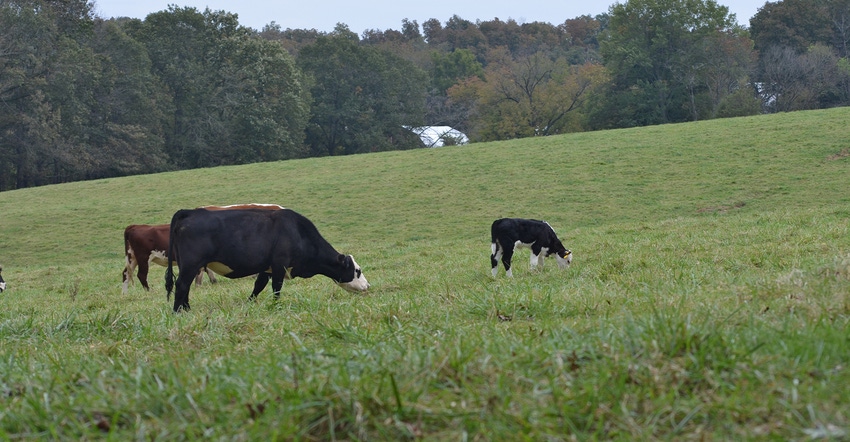November 7, 2019

Recent frosts have producers questioning livestock safety on forages such as johnsongrass, sudangrass, forage sorghum and crosses of those forages.
"Right now, producers should be concerned about prussic acid poisoning,” says Jill Scheidt, University of Missouri Extension agronomy field specialist. “Nitrate poisoning is most commonly associated with high nitrogen applications followed by drought, so unlikely a concern with current conditions.”
Concern for animals
The environmental conditions that favor toxic levels of prussic acid are drought stress and frost damage. After a severe frost, avoid grazing for 14 days or until the leaves turn brown, whichever is longer. Death can result from prussic acid poisoning, most commonly when livestock have fed on plants that have young growth or are stunted by severe drought or frost, Scheidt says.
A potential problem with sorghum-sudangrass is prussic acid or cyanide poisoning.
When sorghum-sudangrass plants are injured or under stress, enzymes that convert glycosides to sugar and prussic acid are released. Levels of cyanide greater than 2 milligrams per kilogram (2 parts per million) of dry plant tissue are considered potentially dangerous. Prussic acid is readily absorbed into the bloodstream and causes toxicity by blocking normal cellular respiration in the animal.
Keep off the grass
Prussic acid levels are highest in young, leafy tissue, whether it is initial growth after planting or regrowth after clipping.
Since it is the young, fast-growing tissue that contains dangerous levels of prussic acid, avoid grazing until the plant reaches a height of at least 24 inches to allow prussic acid to dissipate. Scheidt says that unlike nitrates, which are persistent, prussic acid disappears during the hay curing or ensiling process.
According to Purdue University, in the sorghums, leaf blades normally contain higher prussic acid levels than leaf sheaths or stems, the heads are low in prussic acid, and the seeds contain none. Upper leaves have more prussic acid than older leaves. Tillers and branches ("suckers") have the highest levels because they are mostly leaves and not stalk material.
As plants mature, the stalks make up a greater proportion of the plant, causing prussic acid content in the total forage to decrease. The hazards associated with poisoning may decrease only slightly with age if animals selectively graze those plant parts that are high in prussic acid.
Cold weather may kill only the tops of sorghum plants, leaving the lower portion alive. The unbound prussic acid in this forage does not decline until wilting begins. The forage usually is considered safe to pasture or feed as greenchop five to six days after a killing frost.
Safe zone
New shoots emerging from unkilled portions of the plant are apt to be high in prussic acid, Scheidt says. This forage should not be used until that new growth reaches a height of 2 feet.
In most cases, grain sorghum stubble can be safely pastured because cold weather is likely to have killed the plants before they are grazed. However, the stubble should be observed for dangerous suckers that may develop after the main stalks have been killed. Sorghum that has wilted and dried five to six days after being killed by frost is considered safe for grazing.
Scheidt says greenchop forage is usually safer because it is not selectively grazed. “If livestock are turned into pasture, only the leaves may be eaten; with greenchop material, the total plant is consumed," she adds.
Sorghum silage is generally safe for feeding. Although it could contain toxic levels of prussic acid while in storage, much of the poison escapes as a gas during fermentation and when being moved for feeding. However, as a precaution, do not feed new silage for at least three weeks after harvesting and storing.
The prussic acid content of dry sorghum hay decreases as much as 75% while curing and is rarely hazardous when fed to livestock.
Source: The University of Missouri Extension, which is solely responsible for the information provided and is wholly owned by the source. Informa Business Media and all its subsidiaries are not responsible for any of the content contained in this information asset.
You May Also Like




